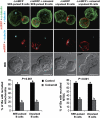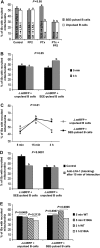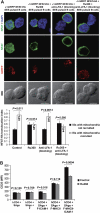Adhesion shapes T cells for prompt and sustained T-cell receptor signalling
- PMID: 20953162
- PMCID: PMC3020646
- DOI: 10.1038/emboj.2010.258
Adhesion shapes T cells for prompt and sustained T-cell receptor signalling
Abstract
During T-cell migration, cell polarity is orchestrated by chemokine receptors and adhesion molecules and involves the functional redistribution of molecules and organelles towards specific cell compartments. In contrast, it is generally believed that the cell polarity established when T cells meet antigen-presenting cells (APCs) is controlled by the triggered T-cell receptor (TCR). Here, we show that, during activation of human T lymphocytes by APCs, chemokines and LFA-1 establish cell polarity independently of TCR triggering. Chemokine-induced LFA-1 activation results in fast recruitment of MTOC and mitochondria towards the potential APC, a process required to amplify TCR Ca(2+) signalling at the upcoming immunological synapse, to promote nuclear translocation of transcriptional factor NFATc2 and boost CD25 expression. Our data show that the initial adhesive signals delivered by chemokines and LFA-1 shape and prepare T cells for antigen recognition.
Conflict of interest statement
The authors declare that they have no conflict of interest.
Figures








Similar articles
-
Occupancy of lymphocyte LFA-1 by surface-immobilized ICAM-1 is critical for TCR- but not for chemokine-triggered LFA-1 conversion to an open headpiece high-affinity state.J Immunol. 2010 Dec 15;185(12):7394-404. doi: 10.4049/jimmunol.1002246. Epub 2010 Nov 15. J Immunol. 2010. PMID: 21078912
-
LFA-1-mediated T cell costimulation through increased localization of TCR/class II complexes to the central supramolecular activation cluster and exclusion of CD45 from the immunological synapse.J Immunol. 2007 Aug 1;179(3):1616-24. doi: 10.4049/jimmunol.179.3.1616. J Immunol. 2007. PMID: 17641028 Free PMC article.
-
Polarized release of T-cell-receptor-enriched microvesicles at the immunological synapse.Nature. 2014 Mar 6;507(7490):118-23. doi: 10.1038/nature12951. Epub 2014 Feb 2. Nature. 2014. PMID: 24487619 Free PMC article.
-
Diversity in immunological synapse structure.Immunology. 2010 Dec;131(4):466-72. doi: 10.1111/j.1365-2567.2010.03366.x. Epub 2010 Oct 29. Immunology. 2010. PMID: 21039474 Free PMC article. Review.
-
The immunological synapse: a cause or consequence of T-cell receptor triggering?Immunology. 2011 Aug;133(4):420-5. doi: 10.1111/j.1365-2567.2011.03458.x. Epub 2011 Jun 2. Immunology. 2011. PMID: 21631496 Free PMC article. Review.
Cited by
-
Calcium microdomains at the immunological synapse: how ORAI channels, mitochondria and calcium pumps generate local calcium signals for efficient T-cell activation.EMBO J. 2011 Aug 16;30(19):3895-912. doi: 10.1038/emboj.2011.289. EMBO J. 2011. PMID: 21847095 Free PMC article.
-
A major secretory defect of tumour-infiltrating T lymphocytes due to galectin impairing LFA-1-mediated synapse completion.Nat Commun. 2016 Jul 22;7:12242. doi: 10.1038/ncomms12242. Nat Commun. 2016. PMID: 27447355 Free PMC article.
-
Mitochondria as central hub of the immune system.Redox Biol. 2019 Sep;26:101255. doi: 10.1016/j.redox.2019.101255. Epub 2019 Jun 15. Redox Biol. 2019. PMID: 31247505 Free PMC article. Review.
-
Dynamic Mitochondrial Migratory Features Associated with Calcium Responses during T Cell Antigen Recognition.J Immunol. 2019 Aug 1;203(3):760-768. doi: 10.4049/jimmunol.1800299. Epub 2019 Jun 14. J Immunol. 2019. PMID: 31201236 Free PMC article.
-
T-cell activation is modulated by the 3D mechanical microenvironment.Biomaterials. 2020 Sep;252:120058. doi: 10.1016/j.biomaterials.2020.120058. Epub 2020 Apr 24. Biomaterials. 2020. PMID: 32413594 Free PMC article.
References
-
- Arimura N, Kaibuchi K (2005) Key regulators in neuronal polarity. Neuron 48: 881–884 - PubMed
-
- Barber DF, Faure M, Long EO (2004) LFA-1 contributes an early signal for NK cell cytotoxicity. J Immunol 173: 3653–3659 - PubMed
-
- Barnard AL, Igakura T, Tanaka Y, Taylor GP, Bangham CR (2005) Engagement of specific T-cell surface molecules regulates cytoskeletal polarization in HTLV-1-infected lymphocytes. Blood 106: 988–995 - PubMed
-
- Barreiro O, de la Fuente H, Mittelbrunn M, Sanchez-Madrid F (2007) Functional insights on the polarized redistribution of leukocyte integrins and their ligands during leukocyte migration and immune interactions. Immunolog Rev 218: 147–164 - PubMed
Publication types
MeSH terms
Substances
LinkOut - more resources
Full Text Sources
Molecular Biology Databases
Miscellaneous

